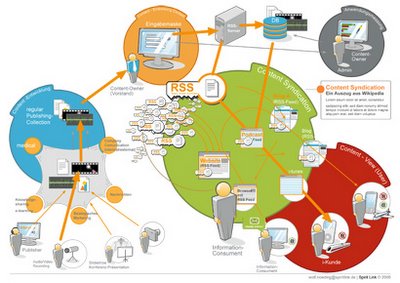>> View the
Conferenz Site of the EURO IA 2005>>
Contacts: Some are in the Euro IA Blog-----------------------------------------------------------------------------------
In short the important messages from the speeches:
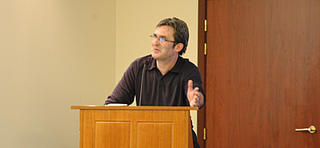 Keynote Speech - Andrew Dillon
Keynote Speech - Andrew Dillon- IA will be relevant in the Web 2.0 movement:
movement from Web 1.0: >> to Web 2.0:> Ofoto >> Flickr
> Mp3.com >> Napster
> Britannica >> Wikipedia
> Personal Page >> Blog
> Taxonomy >> Folksonomy
> Stickiness >> Syndication
> Publishing >> Participation
> Page views >> Costs per clickscreen
- User experience has strongly to do with(triangle): Behavior,
Emotion, Result
- IA is a craft-based discipline > problems with craft disciplines
- Information has more than physical shape: Meaning, Imagery,
Aesthetics, Value, Emotion, Shape
- Diagram for "Designing Usable Electronic Text"
- Beyond navigation: Patterning, Wrappping, Anchoring, Emergent
structure
Data is stored - information is experienced:
- experiences have human consequences
- We are shaping the experience of millions
- How does content impact action
- information breeds
- Usability is a design value, not a competitive field
- And, the discussion between big or little IA won't bring any advantages
-----------------------------------------------------------------------------------
IA in a European Dimension - Peter Bogaards- A view on the rich and big european background (Otlet, etc.)
- UCD (User Centered Design) - European tratition with roots in Scandinavian academics
- Multilingual, multicultural, and multidisciplinary
- Mobility, open source, and Web 2.0
Weaknesses:
- lack of coherence
- different connotations of the term "IA"
- Proficiency in verbal and written English
- Euro economy no big support for IA
- No real IT or internet industry (Apple, Sun, IBM, eBay or Amazon)
- The state-run educational system (very slow integrated programs/reforms, brains move to US)
Opportunities:
- The Lisbon Strategy - stimulation of the knowledge society by the Lisbon Agenda of the European Union
- Initiatives will result in increasing opportunities for IA's to get a job
- Emerging local players idetify user experience in general and information architecture as critical success factor
- Growing IA comunity in Europe
- open source and the so-called "Web 2.0 paradigm of participation"
- The community of European IA must face it's challenges.
-----------------------------------------------------------------------------------
Marketing IA - Experiences and examples from Norway - Mona HallandLessons Learned- Documentation and quantification is powerful
- Keep it simple
- Speek up with a clear voice
-
Forget the Jante law- We all should network and start bloging
-----------------------------------------------------------------------------------
Shared References - Eric ReissCreating effective shared references
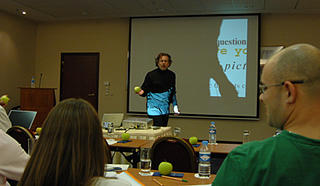
- Creating a shared frame of reference
- What do we have in our toolkit? > visual, words, sound
- CONTEXT IS KING
- Culture can kill individual elements
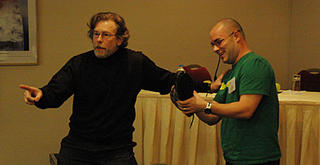
- What are you looking for in a SHOE? > Great example!
- Written descriptions - "But don't just take our words for it"
- Common vocabulary - or foreign language?
- The "as" factor
- "Sometimes size DOES matter (action photos and common objects)
- Ergonomics #1 - wireframes
- Ergonomics #2 - feedback
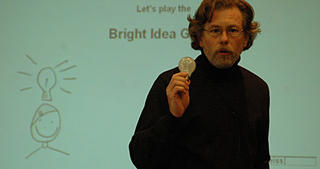 Let's lern from Eric :)!
Let's lern from Eric :)!-----------------------------------------------------------------------------------
The Italian and the English Model - Simone Fuchs&Luca Rosati- Case study
- Berrypicking (change, continue, alter, do)
- Faceted Classification method + vocabulary
- The two Methods described
- Different mental models (I want..., I need..., I'm in Turin, ... )
- An associative model
-
For more information...-----------------------------------------------------------------------------------
Getting Around the BBC- Case study
- Combination of Search, Navigation and Index
- IA is only part of it - three things influence: user experience, infrastructure, Culture
Lessons learned:- Take time to get buy-in at the start
- Need operational and political champions
- Takes a long time to effect change
- Even if IA stuff not that hard - getting it agreed on and implemented
- That means dealing with technology, politics, corporate culture, business processes, etc.
-----------------------------------------------------------------------------------
Putting UX Design at the Heart of the World's Largest IT Projekt - Lit Lewis, Framfrap UK- Case Study
- Why a Common User Interface (UI)?
The approach- Design methodology
- User research
- Designing for safety
- Information standards
- Participation of experts
- Incorporating clinical decision support
IT in healthcare- Healthcare provision must become more efficient
- Historically, IT has been a low priority
- IT is a key part of modernisation
- Efficiencies are possible at the same time as increasing safety & quality of care
- UK primary care
- UK secondary care
- Internationally
- Required cultural shifts
- National diversity
- Different UIs
- Clinical subject areas
- Approach
- Clinical terminology
- Accessibility
- Clinical knowledge framework ("Map of Medicine")
- International adoption (international and own standarts involving other countries)
- NHS NPfIT is leading the world in joined-up healthcare
- NHS has scale to influence international product development
-----------------------------------------------------------------------------------
IA for Augmented Shopping Environments- User-centered Design (UCD) ISO 13407
- Spiral methodology for requirements capture
- Interesting virtual/real shop installation (Prototype)
-----------------------------------------------------------------------------------
Paul Otlet, the man who wanted to Classify the world- From Wikipedia, the free encyclopedia
-----------------------------------------------------------------------------------
Mobile Internet Campaigns - Reinoud Bosman- Building mobile internet sites is complex(markup standards, browser standardization, ...)
-
Approach: Task Analysis, Screenflows, Wireframes(-highlights)
-
Lessons learned: Dead-end IA, End-to-end IA, Forms are a pain, Latency vs. Speed, Minimise memory load, Screen design, Leave out what you don't need,...
-----------------------------------------------------------------------------------
Panel: Using Community Tools to Capture Knowledge in the Organization- Comparing three Systems from the NATO,the BBC and icogs NV
- Blogs, Wiki's, Enterprise Content Management
- each panelist will present one of these solutions
-----------------------------------------------------------------------------------
IA as a Means of Assessing and Creating Organisational Information Coherence- Given that most IA related work starts somewhere in the middle how does one manipulate the client to get into an IA situation?
- Getting a golobal picture
- A Web Site or a Web based Intranet is NOT the place to start!
-
Interesting: Measuring the Value of Metadata(Linda McHugh, Baseline Consulting Group,
www.baseline-consulting.com)
-
Diagram: Metadata Maturity
-----------------------------------------------------------------------------------
IA for the Personal InfoCloudOne of the most interesting sessions- InfoClouds: Personal InfoCloud, Local InfoCloud, Global InfoCloud, External InfoCloud
- Personal InfoCloud (PIC)
- IAs and PICs
- Key Properties of PIC (Person-centered, Access, Organization, Tasks, actions, context aware)
- Person Attracts Information
- Model of Attraction
- MOA-Receptors
- Personal Info Cycle (Seeking, Recognizing, Retaining/Storing, Using/Creating, Following)
- Info Ruse
- Work > Mobile > Home > Office > Driving > Meetings
- How to: PIC for IA
- Granular Content Assessment
- Assemble Information for Use
- Structuring Information
- Focus: Person & Info Reuse
- Design&Develop: Standards
-
Kontakt: Thomas Vander Wal-----------------------------------------------------------------------------------
Wrap-up & 5-minutes MadnessAll readable in the Euro IA Blog -----------------------------------------------------------------------------------
